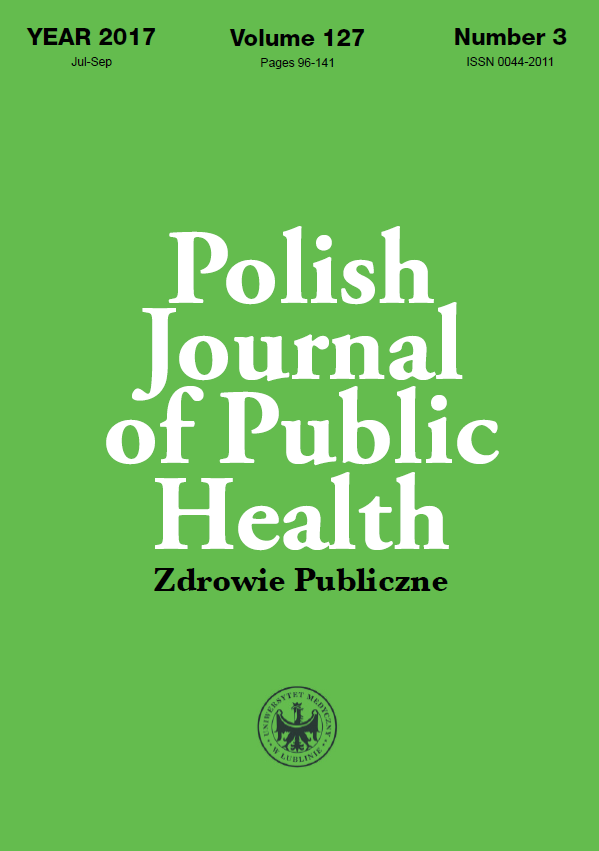Traditional Chinese medicine and Ayurvedic medicine products: a possible cause for concern – the Polish perspective
DOI:
https://doi.org/10.1515/pjph-2017-0028Keywords:
Traditional Chinese Medicine (TCM), Ayurveda, regulation, quality, safetyAbstract
Introduction. The demand for Traditional Chinese Medicine (TCM) and Ayurveda have been increasing and there is great potential for complementary medicine development nowadays. However, there are some safety concerns in relation to these products and they hardly ever meet the European Union (EU) requirements for medicines. Moreover, there is no EU-wide legislation governing the regulation of complementary medicine practitioners.
Aim. This study aimed to evaluate health risks of the Polish, as part of the European, society associated with the use of TCM and Ayurvedic products.
Material and methods. The number of web pages related to TCM and Ayurveda was assessed using popular Internet search engine Google. A questionnaire consisting of 8 close-ended questions was sent to the Polish pharmaceutical and sanitary structures. Chief Sanitary Inspectorate (CSI) in Poland, as well as EU Rapid Alert System for Food and Feed (RASFF) databases, were analysed.
Results. There are thousands of web pages offering TCM and Ayurvedic medicines on the Internet. However, only a few such products are registered for the Polish market, thus only a few are supervised. Between 2007 (Jan) and 2018 (Feb) only 0.8% and 0.4% of all food supplement notifications in Poland were related to products from China and India, respectively. Not supervised illegal TCM and Ayurvedic medicines are in 90% adulterated with undeclared substances.
Conclusions. TCM and Ayurvedic product irregularities may pose serious health risks to Polish consumers.
References
1. CAMbrella. European research network for complementary and alternative medicine. (cited 2018 Feb 2). [http://www.cambrella.eu/home.php?il=28&l=deu.]
2. Chan K, Zhang H, Lin ZX. An overview on adverse drug reactions to traditional Chinese medicines. Br J Clin Pharmacol. 2015;80:834-43.
3. Hegyi G, Petri RPJr, Roberti di Sarsina P, Niemtzow RC. Overview of Integrative Medicine Practices and Policies In NATO Participant Countries. Med Acupunct. 2015;27:318-327.
4. Von Ammon K, Cardini F, Daig U, et al. Health Technology Assessment (HTA) and a map of CAM provision in the EU. CAMbrella Final Report Work Package 5. (cited 2018 Feb 2). [http://www.cambrella.eu/home.php?il=203&l=deu.]
5. Nissen N, Johannessen H, Schunder-Tatzber S, et al. Citizens’ needs and attitudes towards CAM. CAMbrella Final Report Work Package 3. (cited 2018 Feb 2). [http://www.cambrella.eu/home.php?il=203&l=deu.]
6. Teng L, Shaw D, Barnes J. Characteristics and practices of Traditional Chinese Medicine retail shops in London, UK: A cross-sectional study using an observational approach. J Ethnopharmacol. 2015;173:318-29.
7. Fan TP, Deal G, Koo HL, et al. Future development of global regulations of Chinese herbal products. J Ethnopharmacol. 2012;140:568-86.
8. Sammons HM, Gubarev MI, Krepkova LV, et al. Herbal medicines: challenges in the modern world. Part 2. European Union and Russia. Expert Rev Clin Pharmacol. 2016;9:1117-27.
9. Wiesener S, Falkenberg T, Hegyi G, et al. Legal status and regulation of CAM in Europe. Part I – CAM regulations in the European countries. CAMbrella Final Report Work Package 2. (cited 2018 Feb 2). [http://www.cambrella.eu/home.php?il=203&l=deu.]
10. EDQM. Committee of Experts on quality and safety standards in pharmaceutical practices and pharmaceutical care. (cited 2018 Feb 2). [https://www.edqm.eu/medias/fichiers/evaluation_2011_2013_pharmaceutical_care.pdf]
11. Coghlan ML, Maker G, Crighton E, et al. Combined DNA, toxicological and heavy metal analyses provides an auditing toolkit to improve pharmacovigilance of traditional Chinese medicine (TCM). Sci Rep. 2015;10:17475.
12. Van Galen E. Traditional herbal medicines worldwide, from reappraisal to assessment in Europe. J Ethnopharmacol. 2014;158 Pt B:498-502.
13. Chief Sanitary Inspectorate (CSI). (cited 2018 Feb 2). [http://gis.gov.pl/en/]
14. Kaiser H. Traditional Chinese Medicine (TCM) In China and Worldwide 2014-2025. (cited 2018 Feb 2). [http://www.hkc22.com/tcm-fomulasmarket.html.]
15. RASFF Portal. (cited 2018 Feb 2). [https://webgate.ec.europa.eu/rasffwindow/portal/]
Downloads
Published
Issue
Section
License
Copyright (c) 2018 Polish Journal of Public Health

This work is licensed under a Creative Commons Attribution-NonCommercial-NoDerivatives 3.0 Unported License.


